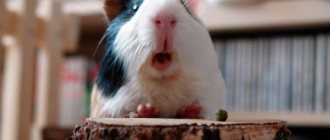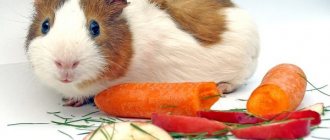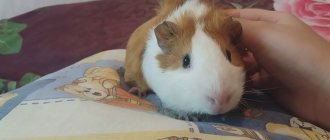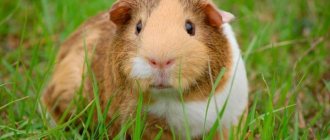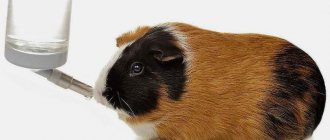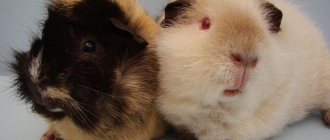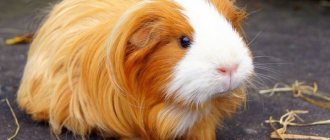Possible reasons why a guinea pig chews on its cage
Such a strange activity not only makes a lot of noise, but also causes the owner to fear for his pet. Therefore, it is important to understand why the animal begins to chew on the cage.
Lack of space
Very often, a pet shows by such actions that it is cramped in its home. The recommended size of the area where a guinea pig lives should be 0.7 square meters. meters. This corresponds to a cell of 100 by 80 centimeters. You can keep the animal in a larger enclosure.
Attention. A small cage can have a negative impact on the pet’s psyche. And the animal expresses psychosis and nervousness by biting and tugging at the bars of its house.
Discomfort
If the guinea pig has no shelter or a place to sleep, then it will also be constantly in tension. It is possible that such strange behavior as gnawing on a cage is nothing more than conveying one’s emotions to the owner.
Boredom
Boredom is often the cause of chewed rods. The animal thus attracts the attention of the owner. A loud crunch and noise makes him come up to the pet, pick him up and give him a treat. Pigs quickly learn new skills and if you want their habits to change, you will have to change yours.
Loneliness
Guinea pigs are social animals, and loneliness has a detrimental effect on them. All this is very serious, so in some European countries it is prohibited to keep such an animal alone. The most suitable option is a same-sex pair of rodents in a cage. In this case, they will always find something to do.
Hunger or lack of micronutrients
Basically, complete food for guinea pigs contains all the necessary vitamins and microelements. But, in some cases, the pet may begin to lack certain minerals. Hunger sometimes also becomes a reason to chew on the bars of the cage.
Do you give your pig extra vitamins?
Grinding down teeth
In order to sharpen its teeth, your pet needs to be given solid food. However, it is sometimes not enough. If the animal does not have special mineral stones, chewing sticks, or branches of fruit trees, then, as an option, it can switch to the bars of the cage.
Attention. The habit of gnawing on a metal cage is harmful to the animal itself. Particles of paint falling off the rods can injure the mucous membranes of the oral cavity and esophagus, causing inflammation or poisoning. A rodent can also break or chip off part of a tooth. Then you will need to have your teeth trimmed by a veterinarian.
Sometimes a rodent needs to be allowed to walk
When is dental care needed?
Djungarian and Syrian hamsters may experience the following problems:
- The upper or lower incisors are broken. If this happens, you need to make sure that the tooth opposite the broken one does not grow too long. It is recommended to trim your teeth so that they grow evenly without growing too much.
- Uneven growth of incisors. The teeth can grow into the palate or cheek pouches and wear down unevenly. Be attentive to your pet; if he becomes restless, behaves strangely, splutters, feels discomfort when lightly pressing on his cheeks, loses weight or eats poorly, this is a reason to immediately take him to the veterinarian.
- If an animal chatters its teeth, it indicates that it is angry or irritated. Hamsters usually react this way to strangers who pick them up.
- Increased salivation most often indicates tooth loss (usually due to injury, although it can happen unnoticed). There is no need to worry, the baby will soon grow a new one.
- Curvature of the incisors does not allow the hamster to eat properly.
- If a malocclusion has formed, the jaws cannot close completely, food gets stuck behind the cheeks, and the hamster feels worse.
What to do and how to stop a guinea pig from chewing its cage
Gnawing on the bars of a cage is a truly bad habit and it will not be possible to wean your pet off of it through training and punishment. In order for the pig to refuse such an action, you need to try to eliminate all the causes of its occurrence.
Necessary:
- Buy a large, spacious cage for the rodent if its living area is smaller than normal.
- Equip the cage with everything necessary for a comfortable stay. Place a shelter there where the pig can hide from prying eyes. Place various toys, a soft bed, and hang a hammock in your pet’s home.
- Sometimes, you can give your pet rodent the opportunity to travel. For this purpose, set up an enclosure or simply take an old blanket and lay it on the floor, enclosing it with drawers. Do not let your pet run around on the table or sofa, as it may fall and get injured.
- Keep your guinea pig clean. These rodents are very clean animals. When there is dirt and disorder around them, they begin to panic.
- Monitor your pet's diet. He must receive sufficient quantities of grain crops and hay. If necessary, introduce fresh vegetables and other succulent food into the diet. To avoid a lack of nutrients, buy vitamin and mineral complexes in granules or tablets. They usually look like treats and pigs eat them with pleasure.
- Give your pet more attention. Play with him, pick him up, talk to him.
- If possible, place your pig with a same-sex pig, they generally get along well with each other.
Attention. If all the conditions are met, but the pet continues to chew on the bars, most likely he has developed an ingrained habit. Try this method: wipe the cage with a menthol-scented cloth. This will not harm either the pig or its home, but it will scare the animal away from such activity for a while.
The rodent needs to grind down its teeth
Providing other conditions
To grind down its teeth, a guinea pig needs hay that is as close as possible to its natural diet. Its constant availability in fresh form will solve the problem of damaged rods.
If several pigs live in a large cage, and one of them tries to chew everything too hard, it is better to move it out. Perhaps this is an innate characteristic or she experiences stress from the excessive presence of representatives of her species.
It is necessary to keep your pet's home clean. Purchased cages last a long time even after frequent disinfection. While washing the animal, it is better to occupy it with something else until it decides to try out new wallpaper or a chair leg. As noted above, in no case should you lay cardboard, even durable cardboard, on the cage pallet.
In the room where the pig lives, you need to maintain a temperature of about 21–230C so that the animal is comfortable and warm. For long-haired individuals, hot weather is a real challenge, so you need to take care of this in the summer in advance.
Guinea pigs, like other pets, love attention and affection. One of the ways they manifest themselves is by treating them to treats.
But don’t give treats too often, otherwise the animal will demand them regularly. A cheerful pet will bring only positive emotions to its owner.
How to grind teeth
A guinea pig's teeth grow throughout his life; if they are not ground down, they will become too long and will interfere with eating. You can't do this without having your teeth trimmed by a veterinarian. This is a huge stress for the animal, so it’s better not to let it get to that point.
What can you do to keep your pet's teeth in order? Provide him with constant access to hay, grass pellets, and wooden toys. You can also put twigs of apple, pear, and coriander in the animal’s home.
The back teeth of a rodent are well ground down with hay and stems of grasses such as sedge and timothy. The front teeth can become worn down when biting into hard vegetables and fruits. Give the animal carrots and unchopped apples.
Thus, the majority of your pet's menu should consist of hay and solid food. In percentage terms it looks like this:
- hay – 60%
- solid food – 20%
- succulent feed – 20%
It is important to give succulent food 2-3 times a day, and solid food should be in the feeder at all times.
Mineral stone solves the problem of teeth grinding very well. It is an excellent nutritional supplement, improving digestion and saturating the animal’s diet with essential substances.
There are stones that contain regular chalk or special pulp flour with vitamin supplements.
Historical facts
Guinea pigs were originally domesticated in Peru, where their meat is still consumed today. At first, the animals were a source of meat food, reminiscent of tender, lean pig meat. Also, rodents were used for sacrifice to bloodthirsty and carnivorous gods.
The name “sea” has nothing to do with its habitat in water. The animal was brought to Europe in the 16th century, and at first it was called “overseas” because it was brought from distant seas and oceans. Over the years, the prefix “for” disappeared, and the pig simply turned into “sea”.
Interesting fact that the capybara is a relative of the guinea pig
Like many modern animals, guinea pigs had distant ancestors. The latter were more similar in size to buffaloes and reached a mass of 70 kg.
Representatives of the Mochiko tribe treated animals as personifications of gods. They were worshiped, sacrifices were made in the form of fruits, and works of art were created in which the animals were the central elements.
Consequences
If the hamster does not cause harm to its health while gnawing on its cage, there is no need to pay special attention to this. It is obvious that he simply enjoys the process itself - not only the busyness, but also the noise it makes. Typically, this weakness affects small rodents. After 6 months they should lose interest in their cage. It is worth knowing that the consequences can be quite serious. The animal can not only break its teeth on metal bars, but also rub its nose quite hard, sometimes even until it bleeds.
Other interesting questions and answers
Why do people like furry animals (seals, rabbits, hamsters, guinea pigs)?
Why do guinea pigs chew their cage?
How to stop a guinea pig from chewing on cage bars.
My guinea pig constantly chews on the bars of his cage; he is always full, but he still chews on it. What to do .
Help please... Guest 7
She grinds her teeth down.
What is better for a four year old child, a hamster or a guinea pig?
For a 4-year-old child, it is better to buy an educational toy, a sports corner, or, if you really want something alive, buy a flower. After the flower goes through the school of survival, it makes sense to get a cat (it has a strong skeleton and can fight back).
Guinea pigs are NOT A TOY and are not easy creatures to care for, you need to be aware of this before purchasing.
- •
First of all, pigs are fragile animals.:
It is easy for her to damage her spine and cause broken bones (she must not be dropped under any circumstances, pigs must not run in a wheel, in a ball, or in any narrow and complex labyrinths). The structure of the sea pig's skeleton, by the way, almost does not protect the internal organs. In case of inaccurate compression/lifting, etc. You can disrupt the vital functions of the body without noticing it at all.
They also have weak immunity: a simple draft can be fatal.
Secondly, the guinea pig is a social (pack) animal.
You MUST of them (human attention is never enough, the animal is sad, plays pranks, screams, gets sick)
Thirdly, the pig needs special conditions of detention:
NO CAGES (cans, boxes), ONLY AVIARY , the minimum size of which for 2 pigs must be at least 1000x700cm.
No wheels, labyrinths, high ladders or shelves. Bedding : either blanket or corn litter (sawdust and wood litter damage the delicate skin of the paws).
Fourthly, kaviya (pig) has a special diet.
Contrary to popular belief, pigs cannot be given many things, for example, cabbage. As a daily diet, a pig should always have: food (from 200 rubles), fresh water, hay, and greens (no more than 2 times a day).
Fifthly, pigs are not particularly tactile and friendly animals.
If you ignore these conditions of detention, you doom a living creature to a painful existence.
- •
I once wrote about more detailed care for this species here, I advise you to read the article in order to weigh all the responsibility that will fall on you/your child after purchasing such a pet.
Evolution of the Walrus into Hedgehog 5
What is better for a four year old child, a hamster or a guinea pig?
For a 4-year-old child, it is better to buy an educational toy, a sports corner, or, if you really want something alive, buy a flower. After the flower goes through the school of survival, it makes sense to get a cat (it has a strong skeleton and can fight back).
Guinea pigs are NOT A TOY and are not easy creatures to care for, you need to be aware of this before purchasing.
- •
First of all, pigs are fragile animals.:
It is easy for her to damage her spine and cause broken bones (she must not be dropped under any circumstances, pigs must not run in a wheel, in a ball, or in any narrow and complex labyrinths). The structure of the sea pig's skeleton, by the way, almost does not protect the internal organs. In case of inaccurate compression/lifting, etc. You can disrupt the vital functions of the body without noticing it at all.
They also have weak immunity: a simple draft can be fatal.
Secondly, the guinea pig is a social (pack) animal.
You MUST of them (human attention is never enough, the animal is sad, plays pranks, screams, gets sick)
Thirdly, the pig needs special conditions of detention:
NO CAGES (cans, boxes), ONLY AVIARY , the minimum size of which for 2 pigs must be at least 1000x700cm.
No wheels, labyrinths, high ladders or shelves. Bedding : either blanket or corn litter (sawdust and wood litter damage the delicate skin of the paws).
Fourthly, kaviya (pig) has a special diet.
Contrary to popular belief, pigs cannot be given many things, for example, cabbage. As a daily diet, a pig should always have: food (from 200 rubles), fresh water, hay, and greens (no more than 2 times a day).
Fifthly, pigs are not particularly tactile and friendly animals.
If you ignore these conditions of detention, you doom a living creature to a painful existence.
- •
I once wrote about more detailed care for this species here, I advise you to read the article in order to weigh all the responsibility that will fall on you/your child after purchasing such a pet.
Evolution of the Walrus into Hedgehog 5
Why do people like furry animals (seals, rabbits, hamsters, guinea pigs)?
Do guinea pigs damage furniture? Are they chewing on something extra?
I have two guinea pigs. Roseate, cute) They don’t chew anything, because I bought them a spacious cage, and they have room to run around. I only let them out under supervision, so with me they can only run around, frolic, and then go back into the cage. As for sawdust, they are sold specially for rodents. It is used as a filler, my pigs do not chew it, but eat hay, which causes their teeth to wear down. I also bought them a special “chalk”. It is hard, with minerals. They chew him too. It is useful not only for teeth, but also for the body as a whole.
Correct selection of design
If the owner plans to buy housing for the pig, and not do it himself, the following rules should be followed:
- The bottom of the cage should be made of material that the pig will not chew.
- The cage must be completely disassembled and must be washed frequently.
- Large size – 60 cm by 100 cm.
- The door must be large enough to easily remove the animal.
- The rods must be strong and not press through.
The best materials are metal, plexiglass and getinax. The first one is highly durable, while the others are easy to clean and disassemble. It is desirable that the design be combined on this issue. Cages made of rubber look beautiful, but can quickly become unusable - the pig chews the bars of the cage made of such material with great pleasure.
If you decide to build a home for your pet with your own hands, you need to make it spacious and durable. You should not use wood or cardboard. He chews the first one, and the second one quickly absorbs feces. This will lead to bacterial growth and infections.
It is best to make the cage yourself from plastic, especially strengthening the bottom, which usually suffers the most. The inside of the cage can be made two-tiered, with many toys.
It is not easy to answer unequivocally which cage is better - homemade or purchased. It is worth choosing the latter option due to the material and long service life. On the other hand, a homemade one is cheaper, which means changing it won’t be difficult.
